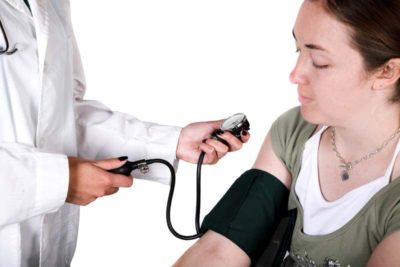
Check your blood pressure regularly.
Hypertension is defined as blood pressure above agreed upon limits. Normal blood pressure is usually agreed to be 120/80. These numbers mean that the “systolic,” or top reading, is 120 millimeters of mercury (mm Hg or 2.32 psi), whereas the “diastolic,” or lower reading, is 80 mm Hg. Systolic refers to when the heart pumps blood out into the system. It is effected by how strong the pulse is and by how well the blood vessels are able to absorb the pressure, or how “elastic” they are. Diastolic refers the resting pressure.
The cardiovascular system is a closed system. It consists of “pipes” which are the blood vessels, a “pump” or heart, and two releasing “valves” or kidneys. The blood vessels (pipes) are connected to each other. The arteries leave the heart (pump) and branch out into 30,000 miles of vessels that connect directly to the returning 30,000 miles of veins. Because this is a closed system changes in the amounts of fluid (blood) and changes in the overall space (vessels) and changes in the force (heart) driving the fluid are all reflected in changes in the blood pressure.
For example, if the kidneys stop releasing fluid then fluid will back up and cause a rise in pressure. If the heart starts pumping very strongly then the pressure will rise. And, if the blood vessels constrict or lose their elasticity then pressure will rise.
This is a dynamic system with all three of these components working together to maintain a healthy blood pressure that ensures delivery of blood to all the cells of the body without jeopardizing any of its parts.
A designation of hypertension is influenced by scientific studies and lobbying efforts. The upper limits have seen two major decreases is the past few years. The upper limits for safe blood pressure as recommended by the American Heart Association has gone from 140/90 to 135/90 to the most recent 130/90 thereby including half the population of the U.S.A.
Very high blood pressure is considered anything over 180/90. Some individuals may have readings higher than 200/100. These are not necessarily alarming, though they need to be addressed. If the pressure stays high for a long period of time then it is a concern that the pressure itself may cause damage. High blood pressure may rupture blood vessels, especially the very small capillaries.
There is a distinction that is made between “long standing hypertension” and “hypertensive urgency” and “hypertensive emergency.” Anyone with hypertension should be followed to monitor what factors effect it and to determine if regulation is appropriate. Hardening of the arteries from a poor diet can cause hypertension as can constriction of blood vessels from high stress. The situation becomes “urgent” when a person starts having symptoms like shortness of breath or swelling in the ankles. This requires attention and probably medication of some kind. An “emergency” situation occurs when the symptoms reflect organ damage caused by the pressure. Examples of organ damage include strokes or disorientation caused by pressure and/or blood vessel ruptures or blockages in the brain and fluid buildup around the heart (congestive heart failure). Also, visual disturbances can signal ruptured vessels in the eyes and blood in the urine can indicate kidney failure. These are all signs that immediate action should be taken to prevent total breakdown and death.
Hypertension is sometimes called the silent killer because people can ignore the signs until organ damage forces an emergency situation.
